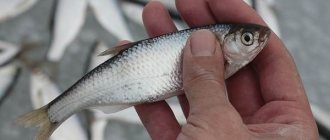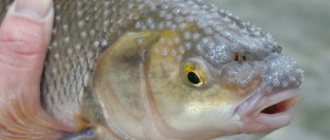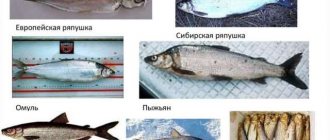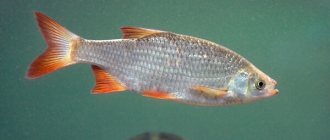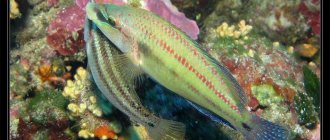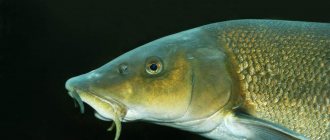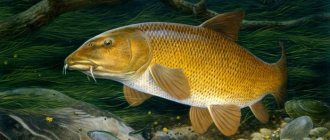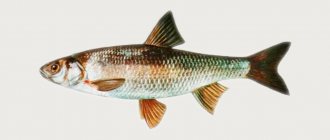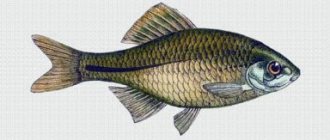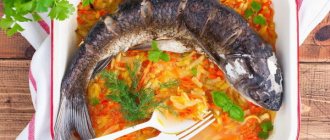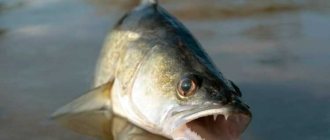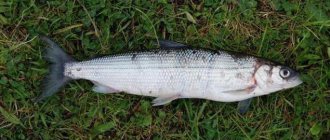Shemaya, or shamaika (from Persian shimaji - king fish), is a ray-finned fish from the carp family, has excellent taste, and is found in the Black, Azov, and Caspian seas. It can reach quite impressive sizes and is very good when dried and salted.
A photo of dried shemaya can excite the taste buds just by looking at the fish.
Until recently, this fish was listed in the Red Book (in different years it had different statuses), and therefore its fishing is significantly limited.
What does shemaya (shemaya) fish look like with photos and descriptions
Shamayka has an elongated body shape, the fish is covered with silvery scales. She has a flat body, which is strongly compressed on the sides. There are silvery-blue tints on the head.
The back has a shiny color and a dark green tint. At the same time, the sides are light in color and shiny. The length of adult individuals is 35 cm, and the weight reaches 650 grams.
A distinctive feature of the fish is the shape of the dorsal fin. He leans back a lot. The front fins of the fish have a beautiful orange color. The Shemaya is characterized by silvery eyes and a large lower jaw.
Interesting fact! The Azov-Black Sea shemaya was removed from the Red Book.
Varieties of king fish
Shemaya has 2 main varieties:
- Caspian shamaika - as the name suggests, it lives in the Caspian Sea. On average, fish weighs 200-250 grams. However, there are individuals whose mass reaches 600 grams. The Caspian Shemaya is characterized by a low body and gray fins. The peritoneum is light in color and covered with dark pigmentation.
- Dnieper Azov-Black Sea shemaya - this fish is considered one of the most valuable representatives of the Azov Sea basin. Its meat has a wonderful taste. It reveals itself especially advantageously when dried.
The Azov-Black Sea variety has a brighter color than the Caspian variety
The difference between shemaya and similar fish - fish and herring
In appearance, the shemaya resembles some representatives of the carp family. It looks like roach, dace, and saberfish. However, most of all, the shemaika resembles a fisherman. However, there are some differences. Thus, the fisherman has a taller and flatter body.
Some fishermen note the similarity of shemaya with Volga herring. But these fish are similar only in appearance. It is worth considering that they belong to different families. The herring has a characteristic forehead and fins of a darker color.
The differences can be seen in more detail in the photo:
Donskaya shamaika
In the photo there is a saberfish
Volga herring
Rybets
External features of the shamaika
Shamaya (its other names: shamaya or shemaya) is a medium-sized fish. The average weight of individuals ranges from 200 to 700 grams. At the same time, the variety living in the Black Sea can grow up to 800 grams, but the inhabitants of the Caspian Sea usually weigh no more than 250 grams. Body length varies from 15 to 30 centimeters.
The body of the shamaika is covered with very small scales. The sides and belly are silver in color, and the back is darker. The base of the dorsal fins is orange, and the fins themselves are almost transparent. The tail is colored gray. The head is not too large, but the lower jaw protrudes strongly forward. This structure is very similar to bleak, so some people cannot distinguish between these types. However, there are two main differences:
- shamaika is 2-3 times larger than bleak,
- The bleak's jaw is closed, since the lower part is turned up and fits into a small hole.
The shamaika has unusual eyes - they are quite large for such a small fish. Their color can vary from silvery white to dark grey. There is a small black dot in the middle of each eye.
Habitats
Shamayka is found and lives in salt water. However, during the spawning period it rises into rivers that flow into the Caspian, Black or Azov seas. At the same time, there is also a rare Aral subspecies of fish that lays eggs near the shores. Between mating seasons, this species of shemai moves to deep-sea areas and almost never enters rivers.
This fish can be found not only in natural conditions. Today there are many farms where shamaika is bred. However, wild fish are considered more valuable because they contain healthy fat. That is why the Black Sea-Azov shemaya is most valued, since it takes a long time to move to the breeding grounds.
Lifestyle
The behavioral features of the shamaika have been poorly studied. However, according to the observations of experts, it is considered a schooling fish that prefers to live in clean water containing a large amount of oxygen. With the onset of darkness, it moves to the upper layers of the reservoir. During the daytime, the fish descend to the depths.
Interesting to know! Schools of this fish mainly live far from the shore. But sometimes they move close.
Spawning features
Shamayka can reproduce literally 2-3 times in its life. At the same time, individual individuals are capable of spawning up to 5 times. Fish go to spawn in small groups that contain more males than females. Immediately after laying the eggs, the eggs move to the sea.
Sexual maturity of females occurs at 3-4 years. At this time, a tubercle forms on their lower jaw. Males can breed as early as 2-3 years. At the same time, their head is covered with thorns.
To lay eggs, the fish chooses shallow areas, the depth of which does not exceed 20-40 cm. There should be no silt or vegetation at the bottom. It is important that it be rocky. Such areas should have clear water and a fairly strong current.
Mating games of shamaikas occur at night. In this case, small eggs move with the current under the stones and stick to them. It takes approximately 5 days for the fry to develop.
The hatched fry are characterized by slow growth. Their yolk bladder resolves only after 1 year. In this case, the body weight does not exceed 1 gram. In this form, the fish move to the sea. It is there that they begin to actively absorb food and gain weight.
The spawning period for different species of shemaya differs significantly. The longest mating season is typical for fish that live in the Kuban River. They begin to spawn in September and finish only in March. Don shamaika spawns in early spring – immediately after the ice melts.
Nutrition
The main food of these fish are the larvae of chironomid mosquitoes. They also feed on aquatic crustaceans, which are found in the middle layer of the reservoir. Schools of king fish actively move around the water area in search of food and eat various aquatic inhabitants, including worms and young fish. Before spawning, the shemaya feeds most actively in order to store more fat.
Lifestyle: nutrition and reproduction
The behavior of the shamaika directly depends on its habitat, which is determined both by its geographical location and the availability of food supply. For example:
- On the territory of Russia, it practically does not leave sea waters. She leaves them only during spawning periods, and then she does not rise very high against the current.
- The shamaika, which lives in the reservoirs of Bavaria, prefers to be near reservoirs that have clean water and are characterized by a rocky bottom structure. This is due to the fact that this fish prefers to inhabit reservoirs with clean water enriched with oxygen.
- Almost all populations of shamaika prefer water bodies with rapid currents. In this regard, it cannot be found in such large rivers as the Volga. In the Dnieper it is found, but in small quantities. Rivers such as the Kuban or Terek are more suitable for her. Here the shamaika population is quite high.
The shamaika is an omnivorous, although not a large fish, more predatory than peaceful. Its diet consists of plankton, as well as all kinds of insects and their larvae, including crustaceans. Already quite adult individuals can hunt fry. Therefore, older individuals should be classified as predators. Particular attention should be paid to the reproduction process, which has certain features. For example:
- After 2 years of life, the shamaika is ready for reproduction.
- Spawning occurs in warm water, for which it moves from seas to rivers.
- Spawning occurs exclusively at night.
- Places for spawning are rifts where there is a fast current, and the bottom in these places is covered with pebbles or stones.
- After spawning, the fish migrate to their usual habitats, and after 3-4 days the first fry appear.
- For 1 year after birth, young shamaika prefer to stay in rivers. After 1 year, the “trifle” moves to the sea, where its growth accelerates greatly.
Catching shemaya - is it possible to catch this Red Book beauty?
Shamayka is listed in the Red Book as it is endangered. Therefore, it is forbidden to catch her. However, local residents often hunt this fish, despite heavy fines. Mostly fishing begins in mid or late April and ends in the second half of June.
Where to find
Most often, fishermen catch Azov shemaya. In winter, a lot of fish can be caught in Terek.
Tackle
To hunt shemaya, you should use a float rod. It is recommended to use long and light rods that have a rigid action. The cross-section of the fishing line should be no more than 0.2 mm. When choosing hooks, you should give preference to number five. The sinker should be conical and weigh 8-15 grams. It is recommended to use a visible float. He must hold the tackle vertically.
We recommend releasing rare fish
We strongly recommend not to purposefully catch shemaya, but to carefully release any that are accidentally caught. Nature must be protected!
How to catch if you still really want to see Shemaya live
Fry are considered the best bait for shemaya. It can also be caught using chopped mussel meat. In addition, you can use shrimp and sea fleas.
At the same time, the tactics of catching shamaika have certain features. It is best to use a float rod for fishing. It should be borne in mind that only small fish live in the upper layers of reservoirs.
The fish bite is sharp and energetic. In this case, the float does not completely fall under the water. To catch a fish, you need to make a quick hook.
Important! In summer, fresh fish spoils very quickly. Therefore, immediately after catching, the shemai must be released, and, as a last resort, salted, dried or smoked.
Lure
For fishing to be successful, it is important to use bait. The best option would be chopped fish or shellfish meat.
Real fishing on Shemaya:
Fishing methods
Fishermen prefer spinning rods. There is no need to use special techniques when catching fish. The catch can be brought by bottom and float gear; modernization is carried out depending on the conditions (sea, river). Shemaika often bites well on fly baits. The choice of gear depends on the area and time of year.
From spring to autumn
In spring, the fish approach the shore; during this period, it is recommended to use float gear for fishing. Fishing with a donk will help ensure a catch in areas with strong currents. In summer, along with other fishing methods, it is recommended to use spinning. Small artificial baits will help attract fish. In summer it is recommended to fish from a boat. In autumn, fishermen use spinning rods and bottom gear for fishing. The latter option provides a catch in areas with a bottom covered with algae and silt.
Fishing in winter
Shemaika can be caught from ice even in winter. Fishing is best done when fishing with a float rod.
How and what to catch
Shemaika practically does not distinguish between baits; it bites on different baits. The optimal time for fishing is the spring month of April. Fishermen use fishing rods and spinning rods. When fishing, it is recommended to use a fishing line of 0.2-0.3 mm, the leash should be thin. The use of a leash is not necessary in areas where there are no bottom snags or sunken trees. Bait will help keep the fish in one place. When catching shemaika, you need to consider the possibility of receiving fines.
Benefits and harms, calorie content
100 grams of shamaika fillet contains only 88 kcal. That is why fish can safely be classified as a dietary product. Moreover, it includes many proteins that contain important amino acids. For athletes, fish helps build muscle tissue; eating this fish helps burn a lot of calories and maintain normal metabolic processes, which helps get rid of excess weight.
Shemai is recommended for pregnant and lactating women. It is also useful for people who face high physical activity or stress. It is best to give fish to children in the form of cutlets, as it contains many small bones.
Shamayka contains a lot of phosphorus, which helps strengthen bone structures and teeth. In addition, this element has a beneficial effect on brain activity. Thanks to the high fluoride content, it is possible to strengthen bones and avoid dental caries.
The composition also contains zinc, which takes part in the production of hormones. A deficiency of this substance in the body negatively affects the condition of hair, nail plates and skin. In men, a lack of zinc causes a disruption in the production of testosterone, which ultimately provokes problems with potency. In addition, zinc helps improve immunity and makes people more resistant to stress.
Royal fish is a storehouse of useful components
Shemaya is considered a completely safe fish. However, it is important for people who are intolerant to fish protein and seafood to eat it with caution. Also, you should not eat fish that has not undergone full heat treatment. The fact is that it may contain parasites.
To improve your health, it is best to eat fish stewed or baked. Smoked and dried shamaika should not be consumed if you have arterial hypertension, kidney or liver pathologies. It contains a lot of salt.
How to cook fish
Shemaya has excellent taste. It belongs to the elite representatives of the carp family. Dried and smoked shamaika is considered especially valuable. At the same time, fish that was caught during the spawning period has the best taste.
The only disadvantage of king fish is the abundance of small bones in the meat. To get rid of them, you can marinate the fish in a weak vinegar solution. It is recommended to do this within 6-8 hours.
Finding fresh or frozen fish for sale can be quite difficult. Most often it is sold dried or smoked. If you manage to buy a fresh product, you should bake it in foil or a sleeve. This will help you get the most juicy dish possible.
How to pickle shamaya - dried shamaya, video recipe:
Shemaya is a tasty and healthy fish that belongs to the carp family. Today, the shamaika is endangered, which is why it is rarely caught in natural conditions. At the same time, many farms are engaged in growing this fish.
